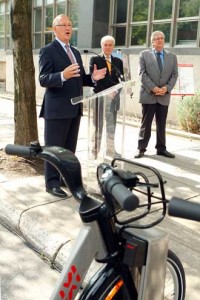
By Pascal Zamprelli
And now some more great news for pedestrians: McGill has announced that lower campus will be virtually car-free by the end of 2010.
Part of a larger Green McGill Project, the plan will allow for limited access by service and delivery vehicles, but there will be no more parking along the lower campus roads and the only regular vehicle entrance will be via the Milton Gate off University Street. It mirrors a current pedestrian-friendly pilot project taking place on McTavish Street, whereby the section of the street between Sherbrooke and Dr. Penfield is dedicated to local traffic only, with a reduced speed limit of 30 km/h. That project is in effect until Nov. 6, and was established in partnership with the City of Montreal and community stakeholders.
As a further testament to McGill and Montreal’s joint commitment to environment and sustainability, Mayor Gérald Tremblay was on campus Monday to announce the creation of a new bicycle path along University St., from Milton St. to de Maisonneuve Boulevard. The idea behind Green McGill, explained Associate Vice-Principal (University Services) Jim Nicell, “is to reclaim all the hard spaces, enhance our green areas, make the campus more accessible, more pedestrian-friendly.”
“So many things are happening that will all bring us to a common goal,” Nicell said. Beyond the car-free lower campus and the current McTavish project, a new James Square sculpture garden will make for a beautiful addition to campus, and there will be a new green look to the terraces outside Stewart Biology, Leacock, and Redpath Library. Expect to see a lot more bike racks as well. But there’s even more to this story than will meet the eye. “Being green doesn’t just mean looking green,” Nicell said, noting that the green initiatives that will transform campus will occur in concert with efforts to encourage sustainable behavior.
“There’s also a lot happening in the background that’s not as visual,” continued Nicell. “People are not as aware of the reduced water consumption, or it’s not so visual if you don’t see as much paper printed here and there. This project gives us the look of green, but think of all the things that come with it if we can reduce the number of people driving through the university, at the same time as increasing the access to our campus for not only our own community but also for the surrounding community. I hope this project will demonstrate commitment of the university, and it will demonstrate it not only to our own community but to the whole of Montreal.”
For Nicell, an environmental engineer by trade who has worked at McGill for nearly two decades, Green McGill represents not only an exciting project, but an opportunity to forge a new culture of sustainability, and to acquit ourselves of the duty we owe future McGillians and Montrealers.
“Sustainability is not just about environment,” he said. It’s about culture, about social issues, about economic issues as well. McGill is not only the owner but the curator of sites of historic importance. With all these steps we’re taking, we’re saying ‘This is McGill, we value it, and we’re preserving it for future generations.’ I’m hoping that people will look back and say ‘boy, some good decisions were made back then’.”
